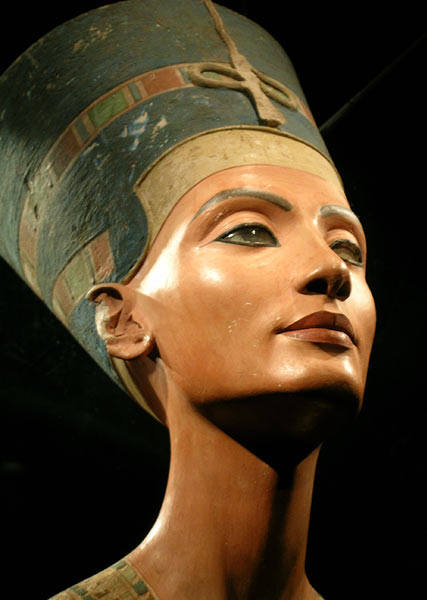Nefertiti
Once a queen of immense beauty ruled alongside Akhenaten during the Amarna Period and helped her beloved Akhenaten promote his new religion. She had a short reign of twelve years and vanished into time. Very little is known about her, but yet she still continues to captivate the world with her beauty. Who was this lady? What exactly is known about her? Come discover this woman that held such an important role in her reign during the Amarna Period.
Nefertiti means, “The beautiful one has arrived.” She lived in Tell El Amarna, located nearly 300 hundred miles south of Cairo. It’s believed that Nefertiti was probably a distant relative to Akhenaten and a favorite queen to the pharaoh. Nothing is known about the queen’s childhood, but first appears in history as Akhenaten's wife. It's believed Akhenaten and his queen brought forth such dramatic changes, that they were unloved by their subjects.
Akhenaten constructed a place to worship Aten, the sun disk god, and named his capitol Akhetaon. This new city was unique and unlike most ancient Egyptian cities. The temples were constructed with no roofs, allowing the rays of the sun to enter the temple. His city had palaces along with villas for the rich, and inhabited almost twenty to fifty thousand villagers.
Supporting her husbands’ beliefs, she changed her name to Neferneferuaten-Nefertiti meaning, “The Aten is radiant of radiance [because] the beautiful one has come.” Nefertiti was more then just a queen, she supported her husband, promoted his religious beliefs, and was depicted more pharaonic, rather then queenly. New findings are proving that Nefertiti was probably one of Egypt’s most powerful queens to ever rule. She was shown with the crown of a pharaoh and was depicted in scenes of battle. Also a large tomb was constructed for her, thought to be a tomb fit for a pharaoh. Although depicted gallantly and heroically, queen Nefertiti loved and cared for her deformed and sickly husband.
Egyptologists also think Akhenaten was born with many deformities that made him handicapped. Akhenaten might have had bad vision, allowing Queen Nefertiti to control and decide many events and situations. Not only did she live as royalty, but next to Akhenaten’s name in a cartouche was hers. This cartouche symbolized her status as a pharaoh and great importance.
Twelve years into the Amarna Period she disappears. Little is known about her disappearance as well. We can only speculate what happened to her. There are many theories to what happened to her. She might have died with an illness or simply became unfavorable to Akhenaten. These may be true, but one ending stands out even stronger then the others. Sometime during the end of the Amarna Period a stone tablet, indicated the death of the king, was sent to the Hittites. She asked the king to send a son to Egypt to wed. She refused to marry any servants. The king of the Hittites sent a son, but was assonated on his journey to marry the queen. Could this be what brought down Nefertiti and the Amarna Period? Although the stone tablets reveal a cry for help, they could have been from Ankhesenamun after the murder of King Tut. Another more new theory is that she could’ve been appointed co-regent of Egypt as well.










